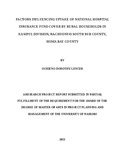| dc.description.abstract | The purpose of the present study was to determine Factors Influencing Uptake of National
Hospital Insurance Fund (NHIF) by Rural Households in Kasipul Division, Rachuonyo SubCounty,
Homa Bay County in Homa Bay County. The study was guided by the objectives: to
determine the extent to which the demographic characteristics influence uptake of NHIF Cover by
rural households in Kasipul Division, Rachuonyo Sub-County, Homa Bay County; to establish the
extent to which socio-economic factors influence NHIF uptake among rural households in
Kasipul Division, Rachuonyo Sub-County, Homa Bay County; to investigate the extent to which
awareness influence NHIF uptake among rural households in Kasipul Division, Rachuonyo SubCounty,
Homa Bay County; and to establish the extent to which institutional factors influence
NHIF uptake in rural households in Kasipul Division, Rachuonyo Sub-County, Homa Bay
County. The study findings was of significance to the Government of Kenya in formulating and
implementing health insurance policy targeting rural households and in their current process of
transforming NHIF into a universal health scheme for every Kenyan. The target population for
this study was rural households drawn from Rachuonyo South District's Kasipul Division in
Homa Bay County. Descriptive study design is adopted while stratified random sampling method
was applied to select the respondents according to the different administrative locations they
come from within Kasipul Division. In this study, the sample size was drawn using the Morgan
Table basing the size of the actual population as per 2009 national population census report. The
data collection tools for this study included questionnaires with both closed and open ended
questions which shall be reviewed, cleaned and coded to minimize errors and enable easy entry
and analysis. Statistical Package for Social Sciences (SPSS) version 20 aided by a computer was
used to organize the data and carry out statistical analysis. At univariate level, descriptive analysis
using frequencies and percentages was carried out while at bivariate level, multinomial logistic
regression was carried out to determine the association between the dependent and independent
variables at 5% level of significance. Besides, the study was valid and reliable in taking the
desired measures to ensure data validity and reliability. The study was based on the basic
assumptions that the data collection instruments was realistic and reliable in taking the desired
reactions. In addition, the study was also assume that the respondents was willing to give
information honestly and distinctively. The survey data revealed that 75% of the respondents or
315 households out of 420 households indicated not having NHIF Insurance Cover against a total
of 105 households or 25% of the households who said they had NHIF Cover. In further
interrogation of the respondents, the researcher established that those who are not covered by
NHIF were mainly those aged between 18 and 35 and are in the informal sector, especially “Jua
Kali” and “Boda Boda Riders”. Others who were not already covered were the small-scale
traders, especially “mama mbogas” who argued that they are not in a position to meet the monthly
NHIF subscription, especially now that the amount is increased. On the other hand, interaction,
the frequency of interacting with NHIF staff was indicated to be very often and influenced uptake
of NHIF significantly. The most effective and common product marketing and sales strategy was
found out to be through local hospitals Finally, financial affordability was seen as being a major
issue with NHIF with a majority of respondents saying that their inability to meet monthly NHIF
subscriptions had incapacitated their ability to take up NHIF cover. | en_US |

